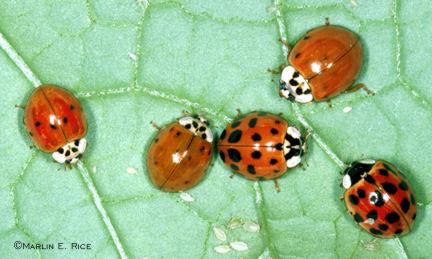It’s that time of year when all types of creatures begin to seek shelter; sometimes in our homes. Not all of these creatures are interested in harming our building structure; they’re just looking for shelter over winter. Some of the most common invaders in large numbers are Asian ladybugs, Brown Marmorated stink bugs, and box elder bugs.
Because I have always loved ladybugs, I'm going to share a few things about them. Most people know that lady beetles, also called ladybugs, eat aphids. Aphids and other soft-bodied insects feed on plants from our landscapes, meadows, a variety of trees and even field crops. In the early 1900s and again in the 1960s-1980s Asian multi-colored lady beetles were imported and released to help control tree-feeding aphids. The reasoning behind this was native lady beetles were not as effective in controlling tree-feeding aphids because so many of our ornamental and fruit trees were from other areas of the world. Now the Asian lady beetle thrives in many parts of North America. During spring and summer, each Asian multi-colored lady beetle will consume over 300 aphids per day. This greatly reduces the need for pesticide use and has benefited the pecan industry by nearly eliminating pecan aphids.
As the weather turns cooler these insects, like the rest of us, want cover from the elements.
Native lady beetles seek shelter mid-Autumn in leaf litter, mulch or around the roots of forest plants. In its home country, the Asian ladybug gathers in large groups to hibernate in cracks and crevices within cliff faces. Here in the southeast, we do not have as many cliffs, so they seek shelter in nooks and crannies of buildings. So each fall until early spring, lady beetles often become a pest in and around homes.
 The Asian lady beetle (stink bugs and box elder bugs do this too) is usually attracted to sunny sides of south and southwest-facing buildings or on light-colored structures that are painted white, gray or yellow. At night, similar to most insects, they are attracted to light. They may cluster against a structure and find a nook or cranny to enter into wall spaces. Many scientists believe they get disoriented from our home heating and start invading the living space looking for a way out. Wouldn't you think it was time to wake up and play if it was so warm? What you should know about these beneficial insects is that they are not interested in eating your walls, furniture, carpet or human food and they do not lay eggs in homes.
The Asian lady beetle (stink bugs and box elder bugs do this too) is usually attracted to sunny sides of south and southwest-facing buildings or on light-colored structures that are painted white, gray or yellow. At night, similar to most insects, they are attracted to light. They may cluster against a structure and find a nook or cranny to enter into wall spaces. Many scientists believe they get disoriented from our home heating and start invading the living space looking for a way out. Wouldn't you think it was time to wake up and play if it was so warm? What you should know about these beneficial insects is that they are not interested in eating your walls, furniture, carpet or human food and they do not lay eggs in homes.
How can we prevent lady beetles from entering our homes?
We can seal cracks and crevices, replace old weather-stripping around windows, and install insect screening over attic vents. All these things can help reduce pest entry and save energy costs. For large infestations with intolerable numbers of beetles, contact a pest control company to spray the outside of buildings when the beetles appear. Long-term relief may come from planting trees that will shade the southern sides of the house.
If they do get inside, avoid trying to pick up or squash them. They have a reflexive behavior where they secrete an orange substance; actually it is their blood and it can stain walls or fabric. It is better to sweep them up with a soft-bristled brush.
It is not recommended to use pesticides inside the home as they have limited impact if the beetles are under insulation or inside walls. There are also black light traps available commercially or you can contact the Cooperative Extension office for directions on how to make your own.
Sources: http://www.ces.ncsu.edu/depts/ent/notes/Other/goodpest/note107.html http://ohioline.osu.edu/hse-fact/1030.html http://www.wvu.edu/~agexten/ipm/insects/ladybeetle.htm http://www.ipm.iastate.edu/ipm/iiin/ladybeetles.html http://www.ladiesinred.com/faq.htm
Wendi Hartup has worked for NC Cooperative Extension in Forsyth County since 2005. She educates citizens on environmental issues, wildlife control and solutions to stormwater runoff. You may find Wendi in a local creek looking for indicator organisms, instructing how to fix erosion with a rain garden, identifying aquatic weeds or advising how to get rid of creepy crawlies. Prior to Extension, Wendi spent 9 years teaching Alabama citizens how to evaluate physical, chemical and biological characteristics of water. Wendi has an M.S. in Fisheries Conservation from Auburn University and a B.S. in Marine Biology from Troy University. To learn more about Wendi and her work contact her at wendi_hartup@ncsu.edu.